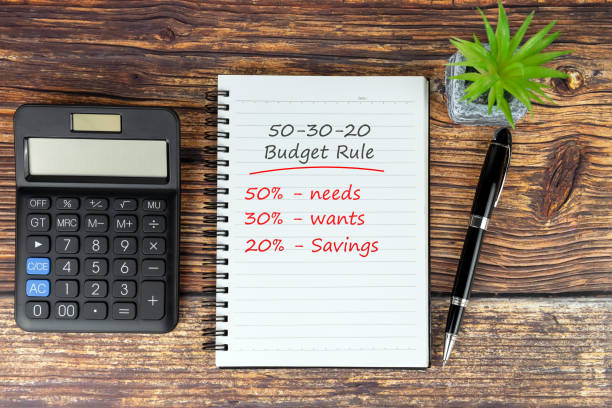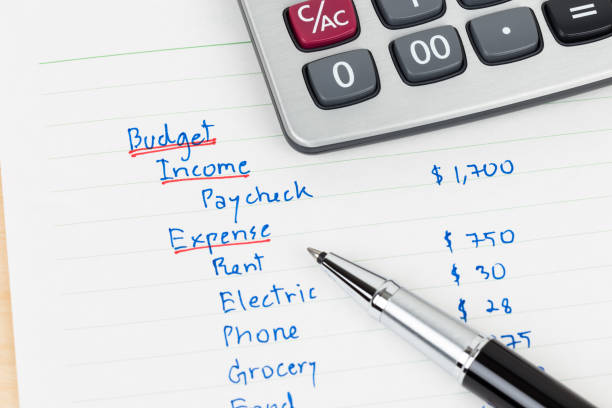Being on top of one's personal finances is an essential life skill. Many find themselves overwhelmed by the complexities of budgeting, with so many expenses, investments, and lifestyle choices to balance. This is where the 50-30-20 budgeting guideline can be truly useful. This simple yet efficient rule ensures your income is distributed in a way that supports long-term stability and financial wellbeing. It provides a clear, structured approach to managing your money.

What is the 50-30-20 Budgeting Rule?
The 50-30-20 rule is a straightforward financial strategy to help individuals efficiently allocate their post-tax income. It suggests dividing your earnings into three distinct categories: 50% for needs, 30% for wants, and 20% for savings or debt repayment. By sticking to this rule, you create a balanced financial plan that covers your essential expenses while allowing room for discretionary spending and future savings.
Originating from the book "All Your Worth: The Ultimate Lifetime Money Plan" by Elizabeth Warren and Amelia Warren Tyagi, the 50-30-20 rule has gained popularity due to its simplicity and adaptability. It's a guideline that can be easily followed by anyone, regardless of income level or financial know-how, making it a widely recommended approach by financial advisors and experts.

Understanding the 50% for Needs
At the heart of the 50-30-20 rule is the allocation of 50% of your income to needs. These are the expenses essential for survival and maintaining a basic standard of living. They include housing costs, utilities, groceries, transport, insurance, and minimum loan payments. Essentially, needs are the non-negotiable expenses you must cover to ensure your wellbeing.
What counts as a need?
Accurately identifying your needs is crucial for applying the 50-30-20 rule. Needs are the expenses you'd really struggle to live without, like rent or mortgage payments, electricity bills, and essential food items. It's important to distinguish between needs and wants to avoid overestimating this portion of your budget.
Calculating your needs correctly
Start by thoroughly assessing your current expenses. Gather all your bills and necessary payments, and add them up. If your total exceeds 50% of your income, it may be time to re-evaluate your spending on certain needs. For instance, you could examine whether your housing is more expensive than necessary or if there are ways to cut utility costs.

Avoiding Common Pitfalls When Categorising Needs
A common mistake is misclassifying wants as needs. Dining out, subscription services, or a new wardrobe may feel essential, but they actually fall under the "wants" category. By strictly defining your needs, you ensure accurate income allocation, which is crucial for the success of this budgeting method.
Allocating 30% for wants
The next 30% of your income in the 50-30-20 rule is designated for wants. This covers non-essential spending—things that improve your quality of life but aren't necessary for survival. Think of it as the discretionary part of your budget, where you have the freedom to indulge in what makes life enjoyable.
Distinguishing Between Wants and Needs
Telling the difference between wants and needs can be tricky, but it's essential for effective budgeting. While a reliable internet connection may be a need for someone working from home, premium TV packages or frequent dining out are wants. Understanding this distinction helps prevent overspending and keeps your budget on track.
Spending wisely on wants
Spending on wants is where you have the most flexibility, but it's also where overspending can derail your financial goals. The key is to prioritise what truly enhances your life. Whether it's a hobby, entertainment, or occasional luxuries, ensure these expenses align with your values and long-term objectives. This conscious spending approach lets you enjoy your wants without guilt or financial strain.

Tips for Reducing Unnecessary Wants Spending
Even within the wants category, there's room for frugality. Opt for experiences over material possessions, consider second-hand options, or find low-cost alternatives for entertainment. Regularly tracking your discretionary spending can also help you identify overspending patterns, enabling you to make adjustments.
Maximising the 20% for savings
The final 20% of your income under the 50-30-20 rule is earmarked for savings and debt repayment. This portion is crucial for building financial security and achieving long-term goals, such as buying a home, starting a business, or having a comfortable retirement.
The Importance of Savings and Investments
Savings aren't just for emergencies; they're the foundation of your financial future. This 20% should be divided between building an emergency fund, contributing to retirement accounts, and investing in assets that will grow over time. By prioritising savings, you create a safety net that protects you from setbacks and allows for future opportunities.
Allocating the 20% for maximum growth
To make the most of your savings, consider a diversified approach. Allocate funds to an emergency savings account, contribute to retirement vehicles like a 401(k) or ISA, and explore investment opportunities aligned with your risk tolerance. Over time, these investments can compound, significantly enhancing your financial position.

The Crucial Emergency Fund
An emergency fund is essential for financial resilience. It covers unexpected expenses like medical bills, car repairs, or job loss without derailing your budget. Aim to save at least three to six months' worth of expenses in an easily accessible account to ensure you're prepared for any financial surprises.
The Advantages of the 50-30-20 Budgeting Rule
The 50-30-20 rule's popularity stems from its numerous advantages. It provides a clear, easy-to-follow structure that simplifies budgeting, making it accessible for everyone, regardless of financial background.
Simplified Budgeting with a Clear Structure
One key benefit is the rule's simplicity. By dividing your income into just three categories, it removes the complexity often associated with traditional budgeting. You don't have to track every expenditure in detail, which can be time-consuming and overwhelming. Instead, you focus on broader categories that naturally encompass all areas of spending. This simplicity is particularly helpful for those new to budgeting or who have struggled with more detailed financial plans.
Flexibility and Adaptability of the Rule
Another major advantage is the 50-30-20 rule's flexibility. While the basic structure is fixed, the rule allows for adjustments based on your circumstances. If your income increases, you can allocate more to savings, or if you face temporary hardship, you can adjust your needs and wants percentages temporarily. This adaptability makes the rule practical for various life stages, from early adulthood to retirement.
Building long-term financial stability
By consistently following the 50-30-20 rule, you establish a strong foundation for long-term financial stability. Allocating 20% of your income to savings and debt repayment ensures you're not just living for today but also preparing for the future. Over time, the accumulated savings can lead to significant financial growth, allowing you to achieve major goals without the stress of instability.

The Challenges of the 50-30-20 Budgeting Rule
Despite its advantages, the 50-30-20 rule isn't without challenges. It's important to understand these potential hurdles to determine if it's the right approach for you.
When the Rule Might Not Work
The 50-30-20 percentages are based on general guidelines, which may not suit everyone, especially those in unique financial situations. For instance, individuals in high-cost-of-living areas might find 50% of their income barely covers needs, leaving little room for wants or savings. Similarly, those with irregular incomes, such as freelancers, may struggle to adhere to these fixed percentages consistently.
- Adjusting the Rule for Low-Income Households
For lower-income households, strictly following the 50-30-20 rule can be difficult. Needs may consume a larger portion of income, leaving less for wants and savings. In such cases, prioritising needs and savings over wants, perhaps adjusting to a 60-20-20 or 70-20-10 split, is crucial. The key is ensuring savings remain part of the budget, even if the percentage is smaller.
- Managing irregular income with the 50-30-20 Rule
For those with unpredictable earnings, like freelancers or seasonal workers, applying the 50-30-20 rule requires additional planning. Instead of monthly budgeting, consider using an average income over several months to determine your allocations. Alternatively, during high-income months, set aside extra funds in your savings to cover lower-income periods. This approach allows you to still follow the rule, albeit with more flexibility.

Comparing the 50-30-20 Rule to Other Budgeting Methods
While the 50-30-20 rule is popular, it's not the only budgeting approach available. Understanding how it compares to other strategies can help you decide which is best suited to your financial needs.
1. Zero-Based Budgeting vs. the 50-30-20 Rule
Zero-based budgeting (ZBB) assigns every pound of your income a specific purpose, with no money left unallocated. Unlike the 50-30-20 rule's broader categories, ZBB requires detailed tracking of every expense. While ZBB offers precise financial control, it can be more time-consuming and complex, making the 50-30-20 rule a simpler alternative for those who prefer less detailed management.
2. Envelope Budgeting vs. the 50-30-20 Rule
Envelope budgeting involves dividing your income into various categories (or envelopes) and only spending what's in each envelope for its designated purpose. Once an envelope is empty, no more spending in that category is allowed. The 50-30-20 rule, in contrast, offers more flexibility within its broader categories, making it less restrictive than envelope budgeting. However, envelope budgeting can be more effective for those who need strict spending controls to curb overspending.
Implementing the 50-30-20 Rule in Real Life
Understanding the 50-30-20 rule is one thing; putting it into practice is another. Here are practical steps to help you apply this budgeting strategy.
Getting Started with the 50-30-20 Rule
1. Calculate Your After-Tax Income: Determine your total income after taxes. This is the amount you'll divide according to the rule.
2. Divide Your Income: Allocate 50% to needs, 30% to wants, and 20% to savings. For example, if your monthly after-tax income is £4,000, you'd allocate £2,000 to needs, £1,200 to wants, and £800 to savings.
3. Track Your Spending: Monitor your spending within each category to ensure you're sticking to the rule. Use apps or spreadsheets to track expenses and make adjustments as needed.
4. Review and Adjust Regularly: As your financial situation changes, review your budget and tweak the allocations if your income or goals shift.

Tools and Apps to Help You Follow the Rule
Various tools and apps can assist with implementing the 50-30-20 rule effectively. Apps like Curve, Emma, and Plum allow you to set up budgets aligned with the rule, track spending, and even receive alerts if you're overspending. These simplify the budgeting process and provide visual aids to help you stay on track.
Effective Budget Tracking
Closely tracking your budget is crucial for the 50-30-20 rule's success. Regularly review your spending and compare it to your budgeted amounts. This helps you stay within limits and identify areas where you could save more. Monitoring also allows you to spot trends or changes in your spending habits, enabling informed budget adjustments.
Common Misconceptions About the 50-30-20 Rule
Despite its popularity, the 50-30-20 rule is often misunderstood. Let's address some common misconceptions.
♦ Believing It's too simplistic.
Some critics argue the rule is overly simplistic, failing to account for the complexities of modern finances. While it is true that it doesn't require detailed tracking, this simplicity is actually a strength. It provides a clear, manageable framework that can be adapted to individual needs, making it an excellent starting point, especially for budgeting novices.
♦ The Myth of One-Size-Fits-All
Another misconception is that the 50-30-20 rule is a one-size-fits-all solution. In reality, it's a flexible guideline that can be tailored to various financial situations. Whether you're a high earner, a low-income household, or have an irregular income, the rule can be adjusted to meet your specific needs, proving its versatility.
♦ Personalising the Rule for Your Situation
To make the 50-30-20 rule work for you, don't hesitate to tweak it. If you're focused on debt repayment, you might allocate more than 20% to savings and debt. Similarly, if you're temporarily reducing discretionary spending, you could shift funds from "wants" to "needs" or "savings." The key is understanding your priorities and adjusting the percentages to best support your goals while keeping the rule's overall structure.

Conclusion
The 50-30-20 budgeting rule offers a simple yet powerful framework for managing your finances. By dividing your income into needs, wants, and savings, you create a balanced financial plan that supports both your immediate needs and long-term goals. Whether you're new to budgeting or seeking a more manageable approach, the 50-30-20 rule provides the structure and flexibility needed to achieve financial stability and peace of mind.
Implementing the rule requires discipline and regular review, but the benefits are well worth the effort. From reducing financial stress to building a secure future, this budgeting method can help you take control of your money and live a more financially empowered life.
Inputs by Agencies
Image Source: Multiple Agencies
Ⓒ Copyright 2024. All Rights Reserved Powered by Vygr Media


























